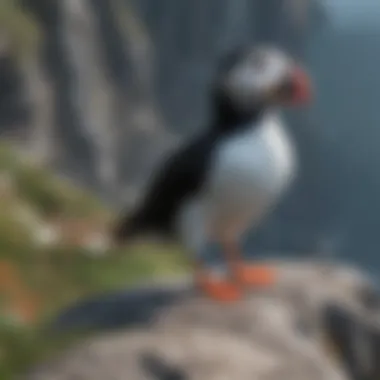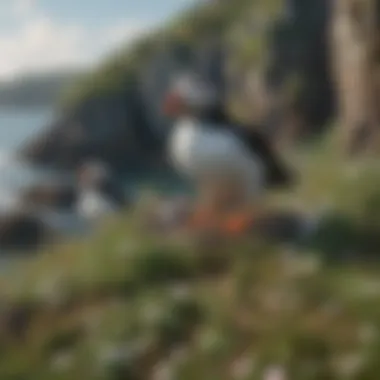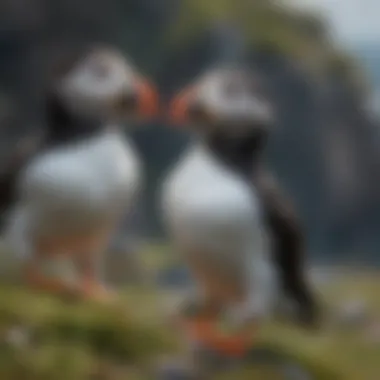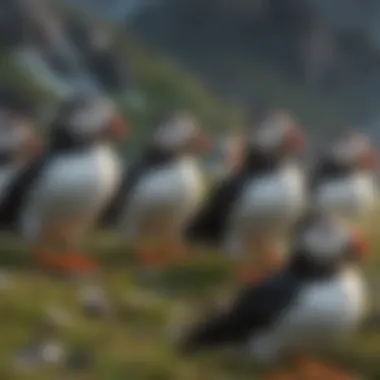Unveiling the Enchanting Habitat of Puffins: Where These Birds Choose to Reside


Nature Topic Overview
Despite their small size and distinctive appearance, puffins are remarkable creatures that thrive in some of the harshest environments on Earth. These seabirds, with their colorful beaks and unique waddling walk, have garnered the fascination of both young and old nature enthusiasts. The habitat of puffins offers a window into a world where survival skills are honed to perfection amidst challenging coastal conditions.
Fun Facts and Trivia
- Puffins are expert divers, capable of plunging up to 60 meters below the water's surface in search of food.
- These seabirds are skilled flyers, reaching speeds of up to 55 miles per hour while in flight.
- Puffins form strong pair bonds and often mate for life, showing remarkable loyalty to their partners.
- Puffins are primarily fish-eaters, with sand eels being a favorite food source for these avian consumers.
- Puffins are charismatic birds that have inspired joy in many through their comedic behaviors and striking appearances.
Wildlife Explorations
Amidst the habitat of puffins, other fascinating marine species also find their homes. From sleek seals basking on sun-warmed rocks to agile otters weaving through kelp forests, the ecosystem is teeming with diverse wildlife. Plants such as hardy sea thrift and vibrant lichens cling to cliff edges, adding a splash of color to the rugged landscape.
Environmental Awareness
Conservation efforts are crucial to maintaining the delicate balance of puffin habitats. By reducing plastic usage and supporting sustainable fishing practices, individuals can contribute to preserving the environment that puffins rely on. Educating children about the importance of biodiversity and ecosystem conservation instills a sense of responsibility towards protecting these vital natural spaces.
DIY Nature Activities
For young nature enthusiasts eager to delve into the world of puffins, engaging in hands-on activities can deepen their understanding. Crafting paper puffins with colorful beaks or constructing miniature puffin habitats from recyclable materials can spark creativity while promoting environmental awareness. Outdoor explorations to coastal areas may reveal traces of puffin presence, such as distinctive burrows or nesting sites, offering a firsthand glimpse into the lives of these charming seabirds.
Introduction
In the realm of avian marvels, few creatures captivate the imagination quite like puffins. These charming seabirds, with their distinctive appearance and endearing behaviors, are a subject of intrigue for scientists and nature enthusiasts alike. As we embark on a journey to unravel the enigmatic habitat of puffins, we are invited to explore the intricate ecosystems that support their existence.
Understanding Puffins
The Charm of Puffins
Embarking on an exploration of the realm of puffins unveils a world where uniqueness reigns supreme. The charm of puffins lies in their striking appearance, characterized by vibrant beaks that echo the hues of a painter's palette. These beaks, not merely ornamental, serve as crucial tools for both communication and hunting. The adaptation of puffins to their coastal habitats showcases nature's ingenuity at its finest, making them exemplary subjects for study and admiration in this insightful article.
Puffins: A Brief Overview
Puffins, with their whimsical presence and graceful flight, offer a mesmerizing spectacle for those fortunate enough to witness them in their natural habitats. A brief overview of these captivating creatures reveals a lifestyle intricately woven into the fabric of coastal cliffs and remote islands. Their adeptness in traversing both land and sea presents a narrative of resilience and adaptation that enriches the overarching theme of this article.


Significance of Habitat
Role of Habitat in Puffin Survival
Delving into the integral relationship between puffins and their habitats sheds light on the essence of sustainability in the avian world. The role played by habitat in ensuring the survival of puffins transcends mere shelter; it embodies a symbiotic bond that dictates the very fabric of their existence. Understanding this role is pivotal in grasping the fragility and resilience intertwined within the realms of avian ecosystems, offering profound insights into the circle of life within this exquisite exploration.
Impact of Habitat Loss
The ramifications of habitat loss reverberate far beyond the mere physical displacement of puffins. It jeopardizes the delicate balance between these charismatic birds and their surroundings, posing existential threats that ripple through entire populations. The impact of habitat loss serves as a poignant reminder of the interconnectedness of all life forms on our planet, urging us to reflect on our responsibilities as stewards of the environment in this crucial elucidation.
Ideal Habitats for Puffins
Being critical in understanding the natural habitat of puffins, the section on Ideal Habitats for Puffins sheds light on the paramount significance of this topic within the broader context of the article. Ideal habitats play a pivotal role in the survival and well-being of puffins, offering them a suitable environment for nesting and thriving. The discussion delves into specific elements that characterize these ideal habitats, emphasizing the benefits they provide to puffins in terms of shelter, protection, and access to essential resources.
Coastal Cliffs and Islands
The Appeal of Coastal Cliffs
At the forefront of puffin habitats, coastal cliffs are renowned for their rugged beauty and strategic location. Coastal cliffs provide puffins with a safe haven for nesting, away from ground predators and disturbances. Their vertical cliffs offer natural protection, reducing the risks of predation and ensuring the safety of puffin colonies. This unique feature is instrumental in maintaining the well-being of puffins, making coastal cliffs a popular choice for nesting grounds.
Remote Islands: Puffin Paradises
Remote islands stand out as idyllic havens for puffins, offering seclusion and tranquility away from the mainland. These islands provide the perfect isolation for puffins to thrive undisturbed, fostering a peaceful environment for nesting and raising their young. The seclusion of remote islands minimizes human interference, creating a sanctuary for puffins to flourish without external disturbances. Despite their isolation, these islands present challenges such as limited access to resources, making them a double-edged sword for puffin habitation.
Factors Influencing Habitat Choice
Impact of Predators
The presence of predators significantly influences puffins' choice of habitat, shaping their breeding and nesting behaviors. Predators pose a constant threat to puffin colonies, prompting them to seek habitats that offer natural defense mechanisms against predatory attacks. Puffins instinctively select locations that minimize the risks posed by predators, ensuring the safety and security of their offspring. The adaptation to predator pressure underscores the importance of habitat selection in ensuring the survival of puffin populations.
Availability of Food Sources
The availability of food sources serves as a fundamental factor in determining puffins' habitat choice and distribution. Puffins rely on abundant food supplies, particularly small fish like sand eels, to sustain themselves and their chicks. Habitats rich in fish populations attract puffins due to the abundance of nourishment essential for their survival. The access to reliable food sources influences their habitat preferences, driving puffins to select areas with ample food availability for successful breeding and offspring rearing.
Global Distribution of Puffins


Puffins are fascinating seabirds with a widespread global distribution. Understanding the global distribution of puffins is crucial in gaining insights into their habitat preferences and conservation needs. By examining the distribution patterns of puffins, researchers can identify key areas for protection and management, contributing to the long-term survival of these charismatic birds.
North Atlantic Puffins
Regions with High Puffin Populations
The North Atlantic region is renowned for hosting significant puffin populations, with coastal areas of countries like Iceland, Norway, and the United Kingdom serving as prime puffin habitats. These regions provide ideal nesting sites on sea cliffs and offshore islands, offering ample food resources for puffins. The rugged coastlines and abundant fish stocks make the North Atlantic a preferred breeding ground for these seabirds. Puffins thrive in the cool waters and varied landscapes of the North Atlantic, showcasing their adaptability to diverse environmental conditions.
Migration Patterns
Migration is a vital aspect of puffin behavior, with North Atlantic puffins embarking on long journeys to find food and suitable breeding grounds. These migratory patterns play a critical role in the survival and reproductive success of puffin populations. By understanding the migration routes of North Atlantic puffins, conservationists can address threats along these pathways and ensure the protection of key stopover sites. Despite facing challenges during migration, such as changing ocean conditions and predation risks, puffins demonstrate remarkable resilience in navigating vast distances to sustain their life cycle.
Pacific Puffins
Distinctive Habitat Characteristics
Pacific puffins inhabit the coastal regions of countries like Russia, Japan, and the United States, showcasing distinctive habitat characteristics that set them apart from their North Atlantic counterparts. These birds prefer nesting in burrows or crevices along rocky coastlines, utilizing their strong bills for excavating suitable shelters. The diverse marine environments of the Pacific Ocean offer rich feeding grounds for puffins, supporting their dietary needs during different life stages. Pacific puffins exhibit unique adaptations to the coastal habitats they inhabit, blending seamlessly into the rugged landscapes they call home.
Challenges Faced
Despite the abundance of food resources, Pacific puffins face various challenges in their habitat, including competition for nesting sites and predation from terrestrial and avian predators. Climate change impacts, such as shifting ocean temperatures and extreme weather events, also pose significant threats to Pacific puffin populations. Conservation efforts in the Pacific region focus on mitigating these challenges through habitat restoration, predator control measures, and community-based initiatives. Protecting the distinctive habitat characteristics of Pacific puffins is vital for ensuring the continued existence of these captivating seabirds.
Adaptations for Habitat Survival
Physical Characteristics
Waterproof Feathers
Waterproof feathers are a defining feature that sets puffins apart and contributes significantly to their survival in marine environments. These feathers repel water, keeping the birds dry and buoyant while diving for food. The key characteristic of waterproof feathers is their ability to prevent water from saturating the bird's plumage. This adaptation is crucial for puffins as it enhances their insulation and maintains their body temperature in cold waters. The unique structure of waterproof feathers, with special oils and interlocking barbules, ensures the bird remains warm and buoyant, vital for their habitat survival.
Webbed Feet for Swimming
Puffins rely on their webbed feet for efficient swimming, essential for navigating the waters in search of food. The webbing between their toes acts as paddles, propelling them through the water with agility and speed. This adaptation is particularly beneficial for puffins as it aids in capturing prey and evading predators. The key characteristic of webbed feet is their hydrodynamic design, enabling precise and swift movement underwater. While webbed feet are ideal for swimming, they can be a hindrance on land, making walking more challenging. Despite this disadvantage on solid ground, webbed feet are indispensable for puffins in their aquatic habitat.
Behavioral Strategies


Burrow Nesting
Burrow nesting is a common behavioral strategy among puffins that provides them with shelter and security during their breeding season. Puffins excavate burrows in the soil or use natural crevices in cliffs to create nests, where they lay their eggs and raise their young. The key characteristic of burrow nesting is its protective nature, offering insulation and protection from predators. This behavioral adaptation ensures the survival of puffin chicks in environments prone to disturbances. While burrow nesting provides safety, it can limit the birds' mobility and expose them to risks within confined spaces.
Social Communal Living
Puffins exhibit social communal living by forming large colonies where individuals interact, communicate, and cooperate. This behavioral strategy fosters a sense of community among puffins, providing collective security and resource sharing. The key characteristic of social communal living is the collaborative nature that benefits the entire colony. By working together, puffins enhance their foraging efficiency and predator detection. Despite the advantages of social living, competition for resources and conflicts within the colony can arise, impacting individual puffins' survival. Overall, social communal living enhances puffins' adaptability and resilience in their habitats.
Conservation of Puffin Habitats
The conservation of puffin habitats holds paramount importance in this article as it delves into the intricate balance between preserving these unique ecosystems and the survival of the charming puffin population. Understanding the threats faced by these birds due to habitat degradation and loss sheds light on the critical need for conservation efforts. Conservation measures not only safeguard the habitats crucial for puffins' nesting and breeding but also play a crucial role in maintaining biodiversity and ecosystem health. By highlighting the significance of conserving puffin habitats, this article aims to raise awareness and inspire action to protect these vital environments.
Threats to Habitat
Climate Change Impact
The far-reaching impact of climate change on puffin habitats is a pressing concern that cannot be overlooked. The rising sea levels, unpredictable weather patterns, and ocean acidification directly threaten the stability of coastal cliffs and remote islands where puffins thrive. The changing climate disrupts food availability, alters nesting conditions, and escalates the vulnerability of puffin populations. Addressing the specific challenges posed by climate change is imperative to mitigate its detrimental effects on puffin habitats and secure a sustainable future for these iconic birds.
Human Disturbances
Human disturbances pose an imminent threat to puffin habitats, compromising the fragile balance of these ecosystems. Activities such as tourism, development, pollution, and overfishing disrupt the natural habitats of puffins, leading to habitat fragmentation and degradation. The disturbance caused by human activities not only displaces puffins from their traditional nesting grounds but also exposes them to increased predation and food scarcity. Recognizing and mitigating the impact of human disturbances on puffin habitats is crucial to ensure the long-term survival of these seabird colonies.
Protection Efforts
Campaigns for Habitat Preservation
Campaigns for habitat preservation serve as vital initiatives in safeguarding puffin habitats from further deterioration. These specialized conservation efforts raise awareness, advocate for policy changes, and mobilize resources to protect critical puffin habitats. By engaging in targeted campaigns, conservation organizations and local communities work collaboratively to implement sustainable conservation practices and preserve the fragile ecosystems essential for puffin survival. Supporting campaigns for habitat preservation is key to promoting the protection of puffin habitats and fostering a culture of environmental stewardship.
Community Involvement
Community involvement plays a pivotal role in the protection of puffin habitats by fostering local ownership and sustainable conservation practices. When communities actively participate in habitat restoration projects, monitoring efforts, and advocacy campaigns, they contribute significantly to the preservation of puffin habitats. Community-driven initiatives not only enhance the resilience of puffin populations but also promote a sense of shared responsibility towards environmental conservation. Empowering communities to take an active role in protecting puffin habitats strengthens conservation outcomes and nurtures a harmonious relationship between humans and wildlife.
Conclusion
In wrapping up the exploration of Puffin habitats, it is imperative to underline the critical role that understanding these avian ecosystems plays in their conservation and sustenance. By delving into the nuances of Puffin habitats, we gain valuable insights into the intricate balance of nature and the impact of human activities on these fragile environments. Highlighting the significance of preserving these habitats is not just a matter of ecological responsibility but also a testament to our commitment to biodiversity conservation and environmental stewardship.
Appreciating Puffins and Their Habitats
Final Thoughts on Puffin Habitats
As we reflect on the final thoughts regarding Puffin habitats, one cannot overlook the harmonious coexistence that these birds foster with their surroundings. The resilience of Puffins in adapting to diverse habitats is a testament to their evolutionary prowess and survival instincts. The final thoughts encapsulate the essence of harmony between Puffins and their environments, underscoring the delicate interplay between species and their habitats. This reflective exploration serves as a poignant reminder of the intricate web of life that binds ecosystems together, urging us to cherish and protect these natural wonders with unwavering dedication and care.







